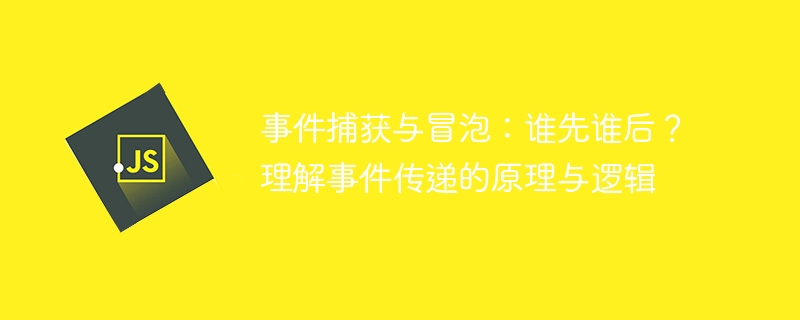

Event capture and bubbling: Who comes first and who comes last? Understand the principles and logic of event delivery
Event capture and bubbling refer to different ways of event delivery when an event occurs on a web page. They are part of the event model in JavaScript. It is very important for web developers to understand the principles and logic of event delivery.
First of all, we need to understand the basic concept of event delivery. Event delivery refers to how the browser delivers events to elements when events are triggered, and how elements handle these events. In web development, the event delivery process can be divided into three stages: event capture stage, target stage and event bubbling stage. Understanding these three stages is very important for us to handle events correctly.
In the event delivery process, the first is the event capture stage. In this phase, the event is passed down from the outermost parent element until it reaches the target element that triggered the event. This approach means that the outermost parent element catches the event first. In the event capture phase, if the target element's parent element is also bound to the same event handling function, the event handling function of the parent element will also be triggered.
The next step is the target stage, which is the stage where the event is actually triggered. In this phase, the event handler function will be executed. At this time, if the target element's parent element is also bound to the same event handling function, the event handling function of the parent element will also be triggered.
The last is the event bubbling stage. In this phase, the event bubbles upward layer by layer starting from the target element until it reaches the outermost parent element or root element. This method means that the target element that triggers the event first eventually bubbles to the outermost parent element or root element.
Understanding the three stages of event delivery, we can better understand the principles and logic of event delivery. The order of event delivery is from the outermost parent element to the target element, and then from the target element to the outermost parent element or root element. Therefore, during the event delivery process, capture first and then bubble. That is, the event first passes down the DOM tree until it reaches the target element, and then bubbles up along the DOM tree. This design helps event processing and bubbling.
Understanding the principles and logic of event delivery is very important for web development. In actual development, we can use the characteristics of event delivery to handle events gracefully. For example, if a parent element and a child element both have the same event handler bound to them, we can avoid executing the same code repeatedly by canceling bubbling during the event capture phase. In addition, we can also use the characteristics of event delivery to implement event delegation, thereby improving performance and code quality. By binding events to parent elements and utilizing event bubbling, you can reduce the number of times you bind events, thereby improving performance, and you can dynamically add or remove child elements without rebinding events.
To summarize, event capturing and bubbling are two important concepts in the event delivery process. Understanding their principles and logic can help us better handle events and optimize code performance. Applying the principles and logic of event delivery in actual web development can improve development efficiency and achieve a better user experience.
The above is the detailed content of Event capturing and bubbling: who comes first and who comes last? Understand the principles and logic of event delivery. For more information, please follow other related articles on the PHP Chinese website!




